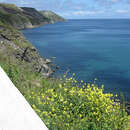Biology
(
İngilizce
)
Arkive tarafından sağlandı
The Lundy cabbage supports a unique pair of insects which, like the plant itself, occur nowhere else. These are the Lundy cabbage flea beetle (Psylliodes luridipennis) and the Lundy cabbage weevil (Ceutorhynchus contractus currently var. pallipes). Neither are very obvious, the beetle measuring three millimetres and the weevil only a millimetre-and-a-half. They feed on their host plant and are closely related to mainland beetles.
Lundy Island provides a microcosm of evolution, having been isolated from the mainland of England for some 9,000 years since the end of the last ice age. Many species are able to cross the few miles of sea separating it from north Devon but some seem to be evolving unique traits and behaviour.
Conservation
(
İngilizce
)
Arkive tarafından sağlandı
Both the Lundy cabbage and the Lundy cabbage flea beetle are now included in the UK Biodiversity Action Plan and as part of English Nature's Species Recovery Programme. The immediate objective was the removal of the invading rhododendron from the cabbage's immediate environs. This posed several problems, not least in the hazards involved in clearing large shrubs and bushes from a cliff face.
More accessible plants have been tackled by volunteers and some areas have been cleared although the war is by no means won. The less accessible slopes have been reached by a Bristol-based company called Ropeworks while the National Trust, owners of Lundy Island and their management trustees, the Landmark Trust, have co-ordinated volunteer groups to eradicate rhododendron from the less hazardous areas. This is still a monumental task, however, and the short term plan is to concentrate on the most sensitive areas with the objective of preserving the UK's own 'Galapagos Island'.
Description
(
İngilizce
)
Arkive tarafından sağlandı
A tall and impressive plant, especially when it covers its cliff side habitat in yellow flowers from May to July. When not in flower it resembles a large radish top with leaves in a rosette in winter and early spring. The plant seeds in late summer and autumn.
Habitat
(
İngilizce
)
Arkive tarafından sağlandı
The plant likes areas of bare cliff and places where landslip has occurred. It is found solely on the slate and granite cliffs on the south-east side of Lundy Island.
Range
(
İngilizce
)
Arkive tarafından sağlandı
Currently restricted to Lundy Island in the Bristol Channel. The plant may well have occurred elsewhere prior to the last ice age. Relatives of the Lundy cabbage are found in Spain and North Africa.
Status
(
İngilizce
)
Arkive tarafından sağlandı
Classified as Rare and Endemic in the UK.
Threats
(
İngilizce
)
Arkive tarafından sağlandı
The Lundy cabbage is under threat from another invader, this time a recent one. Rhododendron was introduced to the island as an ornamental plant in the 19th century and now covers much of the cliff top formerly occupied by the cabbage. The threat posed by the rhododendron puts not only the Lundy cabbage at risk but the two insects which depend on it for their survival. Though rhododendron invasion is a problem in many UK sites, Lundy is the only location where it threatens the total loss of a species.

